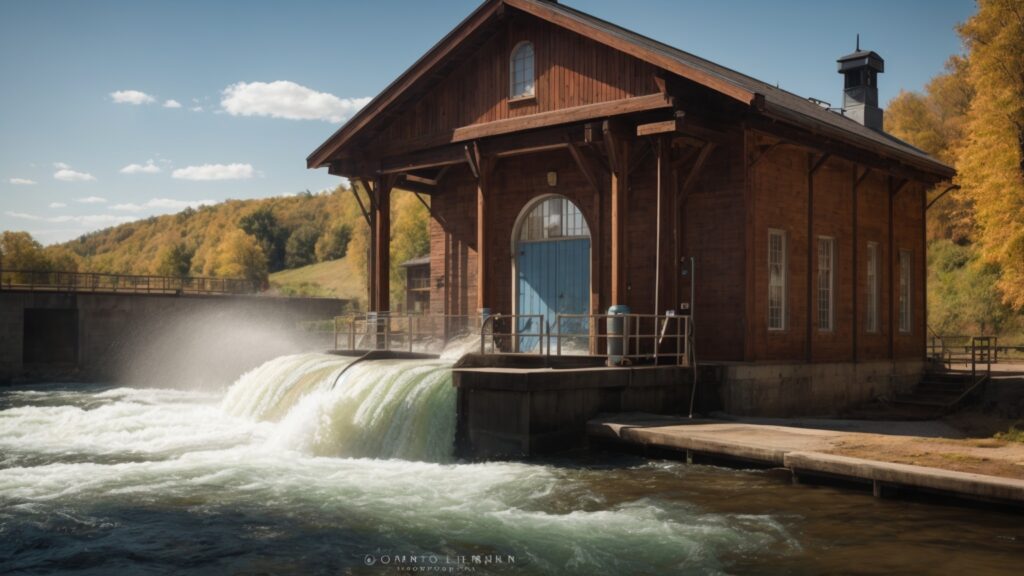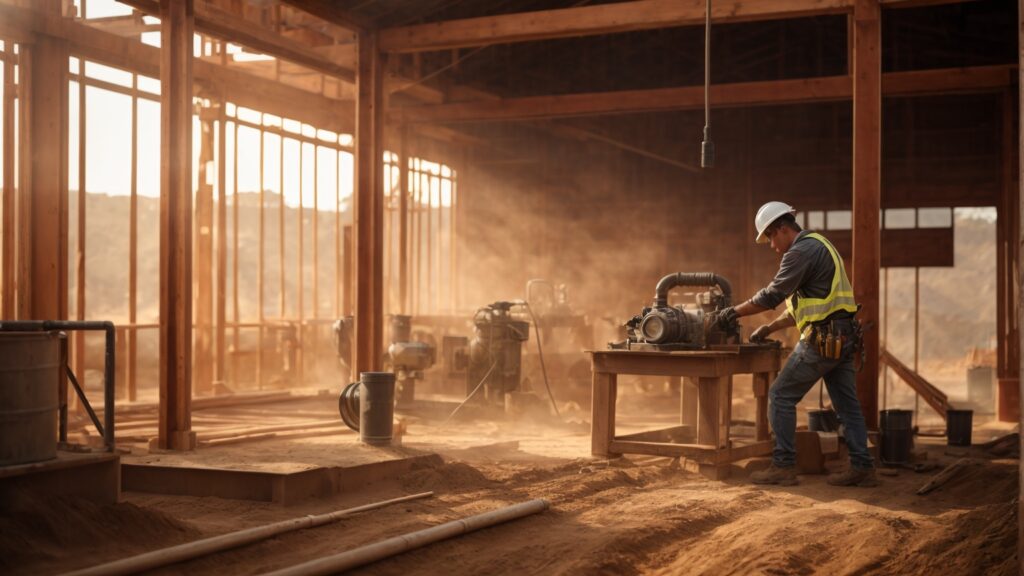Estimated reading time: 9 minutes
Introduction
When planning how to build a pump house, considering the shed‘s size and insulation is vital to safeguard your water pump efficiently. Choosing materials that are both durable and efficient is essential for the build. This introduction outlines a thorough process, detailing step-by-step construction, methods to weatherproof your structure, strategies for financial planning, and routine maintenance and upkeep practices to prolong the life of your pump house.
A pump house acts as a protective shed or garage for your water system, shielding the pump from external harm. Engaging in discussions on forums or consulting with a service provider can illuminate the necessity of constructing beneath the frost line, as well as integrating corners designed to accommodate heating units, hinges for accessibility, and strategies to deter critters. Regardless of whether you’re storing a basic pump or an elaborate system, ensuring proper insulation is crucial, particularly in regions prone to severe temperatures. Weatherproofing your pump house guarantees it withstands various weather conditions, while consistent maintenance ensures it remains operational over time.
Key Takeaways
- Importance of Size and Insulation: Understanding the right size for your pump house and the best insulation practices to protect your water pump.
- Material Selection: Insights into selecting durable and efficient materials for construction.
- Step-by-Step Construction: A comprehensive guide to building your pump house from the ground up.
- Weatherproofing Techniques: Strategies to ensure your pump house can withstand various weather conditions.
- Budgeting Tips: How to effectively plan your finances for this project.
- Maintenance and Upkeep: Regular maintenance tips to ensure the longevity of your pump house.
Understanding the Basics of How to Build a Pump House
Understanding how to build a pump house starts with the critical dig for its foundation, positioned beneath the frost line to avoid freezing. Just as vital is the choice of an appropriate heater to keep the temperature inside the pump house stable, ensuring that the pipes and pump don’t freeze during colder months. This heater helps the system to work smoothly, reducing the likelihood of damage due to ice. Properly executing your dig and selecting a suitable heater are essential steps in creating a strong and effective pump house.
Why Insulation is Essential To Build Pump House
Insulation plays a critical role in maintaining the optimal functioning of your pump house, especially in regions that experience extreme temperatures. Proper insulation helps prevent the pipes and the pump from freezing during winter, ensuring an uninterrupted water supply.
In addition to protection from the cold, insulation reduces noise, making the pump operation less intrusive, especially near living areas.
Key Components To Build A Pump House
- The Pump Itself: Central to the pump house, it drives the water supply.
- Pressure Tank: Regulates the water pressure and ensures consistent water flow.
- Piping System: Facilitates water movement from the well to your home.
“A well-insulated pump house is the backbone of an efficient water system on any property.” – Jack Danny, Well Pump Maintenance Expert
Understanding a pump house’s basic functions and components sets a solid foundation for its construction. It’s not just about building a shelter but creating a well-insulated, efficient, and functional space that ensures the longevity and reliability of your water supply system.

Planning and Designing To Build Your Pump House
In planning and designing to build your pump house, focusing on the well head is essential for individuals wanting to build a sturdy well house. When you’re trying to build a project that also enhances your home improvement efforts and secures your water well, considering the inclusion of a well pit might be useful. Imagine a shelter similar in size to a dog house, with pics serving as a visual guide for how you would build this protective structure. Employing brick and 2×6 boards will offer the strength needed, and the casing protects the well without sacrificing integrity. Adding a cool, efficient generator benefits those living in the country, ensuring the pump house operates effectively in all conditions. This approach, geared towards utility, supports the aim to build something enduring for safeguarding the water well.
Determining the Appropriate Size for Your Pump House
Your pump house should be big enough to house the pump, pressure tank, and other necessary equipment while allowing easy maintenance and repairs. It should also accommodate any future upgrades or additions.
However, bigger isn’t always better. An oversized pump house can be less efficient to heat and harder to maintain. Striking the right balance is key.
Choosing the Right Materials
Durability is essential when selecting materials for your pump house. Weather-resistant materials that can withstand your local climate are crucial.
Insulation materials are equally important. They should be capable of protecting your equipment from extreme temperatures, be it the heat of summer or the chill of winter.
Comparing Different Pump House Designs
| Design Type | Features | Pros | Cons |
|---|---|---|---|
| Traditional Wood Frame | Sturdy wooden structure | Easy to customize, natural insulation properties | Requires regular maintenance |
| Prefabricated Metal | Metal panels and frame | Durable, less maintenance | Limited insulation, less customizable |
| Eco-Friendly | Sustainable materials | Environmentally friendly, often more insulated | Can be more costly and complex to build |
Small Well Solutions: Tailoring Your Design
For smaller wells, the design can be simplified. A compact, efficient structure that covers the essentials – protection, insulation, and accessibility – is often sufficient. This approach not only saves space but can also be more cost-effective.
The planning and design phase is the bedrock of your pump house project. Careful consideration of size, materials, and design will ensure a functional, durable, and efficient structure that meets your needs.
Step-by-Step Construction Guide To Build A Pump House
With your plans and designs, it’s time to move into the construction phase. Building a pump house can be a rewarding DIY project, offering both the challenge and the satisfaction of creating a functional structure for your property. This section provides a detailed, step-by-step guide to help you turn your plans into reality.
Laying the Foundation
The foundation is critical for the stability and longevity of your pump house. Whether you choose a concrete slab, gravel pad, or another type of foundation, it must be level and strong enough to support the structure and equipment.
Consider the drainage around your foundation. Proper drainage will prevent water accumulation, which can lead to moisture issues and affect the integrity of the pump house.
Building the Structure
Start with the frame. Use durable materials like treated lumber or metal beams, ensuring they are properly aligned and secured.
Once the frame is up, add the walls and roof. Consider using insulated panels for extra efficiency, especially in climates with extreme temperatures.
Tools and Materials Needed
- Measuring Tape and Level: For accurate measurements and ensuring everything is level.
- Hammer, Nails, and Screws: Basic tools for construction.
- Saw: For cutting lumber or panels to size.
- Drill: For securing components together.
- Insulation Materials: To protect the pump from temperature extremes.
Building an 8×8 Foot Pump House
An 8×8 foot pump house is often sufficient for a standard well pump. This size provides ample space for the pump, pressure tank, and necessary plumbing while still being manageable for a DIY project. In this guide, we’ll focus on constructing a pump house of this size, with modifications as needed for your specific requirements.
Building your pump house requires careful attention to detail, from laying a solid foundation to constructing a sturdy frame and walls. By following these steps, you can ensure a durable and functional pump house for your property.

Insulation and Weatherproofing Techniques
Introduction: Insulating and weatherproofing your pump house are crucial to ensuring its efficiency and durability. These processes protect your well pump and associated equipment from extreme weather conditions, be it scorching summers or freezing winters, and can significantly extend the lifespan of your water system.
Selecting the Right Insulation Materials
The choice of insulation material can greatly impact the effectiveness of your pump house. Materials like fibreglass, foam board, or spray foam offer excellent thermal resistance and are suitable for most climates.
It’s not just about the type of insulation but also about the correct installation. Ensuring no gaps and that the insulation covers all necessary areas is key to maintaining a stable temperature inside the pump house.
Weatherproofing Techniques to Protect Against Elements
Weatherproofing involves more than just insulation. It includes sealing cracks or openings to prevent moisture and pests that can damage the equipment and structure.
Consider installing a ventilation system to manage humidity and temperature, and use weather-resistant paints or coatings to protect the exterior from the elements.
Insulation Material Comparison and Effectiveness
| Material | Thermal Resistance (R-Value) | Pros | Cons |
|---|---|---|---|
| Fiberglass | R-3 to R-4 per inch | Cost-effective, widely available | Requires protective gear during installation |
| Foam Board | R-5 to R-6 per inch | High insulation value, moisture resistant | It can be more expensive, and requires precise cutting |
| Spray Foam | R-6 to R-7 per inch | Seals gaps effectively, high R-value | Higher cost, professional installation recommended |
Ensuring Longevity: Maintenance Tips
Regularly maintaining your pump house’s insulation and weatherproofing can significantly impact its longevity. This includes checking for any damage to the insulation, ensuring vents are clear, and repainting or sealing the exterior as needed.
Proper insulation and weatherproofing are essential for protecting your pump house from weather extremes and ensuring the continuous operation of your water system. By choosing the right materials and maintaining them well, you can safeguard your investment for years to come.

Cost Analysis and Budgeting
Building a pump house is an investment in your property’s infrastructure. A clear understanding of the costs involved is essential for effective budgeting and avoiding unexpected expenses. This section provides a detailed breakdown of potential costs and tips on budgeting efficiently.
Estimating the Cost of Materials and Labor
The cost of materials can vary significantly based on the size of your pump house and the materials’ quality. This includes the cost of lumber, insulation, roofing materials, and any specialized tools or equipment.
If you choose to hire professionals for certain aspects of the construction, such as electrical work or insulation installation, labor costs must also be factored into your budget.
Budgeting for Unexpected Expenses
Always allocate a portion of your budget for unforeseen expenses. Unexpected issues like soil problems, weather delays, or material price changes can impact overall costs.
Consider the long-term maintenance costs as well. Investing in quality materials and construction techniques can save money on repairs and upkeep in the future.
Breakdown of Potential Costs
- Materials (Lumber, Insulation, Roofing, etc.): Estimated cost based on size and material quality.
- Labor (if hiring professionals): Cost varies based on the complexity of the work and local rates.
- Tools and Equipment: Purchase or rental costs for tools not already owned.
- Contingency Fund: A percentage of the total budget for unexpected expenses.
Saving Money: DIY vs. Professional Construction
While DIY construction can save on labor costs, it requires a certain skill level and time commitment. Weigh the pros and cons of DIY versus hiring professionals, considering factors like project complexity, your skill level, and the value of your time.
Effective budgeting is crucial for the successful construction of your pump house. Understanding and planning for the costs involved can ensure a smooth construction process without financial surprises.
Complementing Your Farm with a Functional Pump House
A well-designed pump house is more than just a functional necessity for your farm. It can significantly enhance the efficiency and aesthetic appeal of your property. This section explores how a pump house can be integrated into your farm operations and customized to meet your needs.
Enhancing Farm Efficiency with a Pump House
A strategically placed and well-built pump house can streamline your farm operations. It ensures a reliable water supply for irrigation, livestock, and other farm needs, boosting overall productivity.
The design of your pump house can also be tailored to complement your farm’s layout and aesthetics. This enhances not only its functionality but also contributes to the overall visual appeal of your property.
Customizing the Pump House to Suit Farm Needs
Consider the specific requirements of your farm when designing your pump house. This includes the size and capacity of the pump, storage needs, and accessibility for maintenance.
Features like temperature control, ventilation, and security can further optimize the pump house for farm-specific applications.
Examples of Pump Houses on Successful Farms
- The High-Capacity Pump House: Designed for large-scale irrigation systems.
- The Compact Pump House: Ideal for small farms or homesteads.
- The Eco-Friendly Pump House: Utilizing sustainable materials and solar power.
“Our custom-built pump house has been a game changer in managing our farm’s water needs efficiently and reliably.” – Jane Smith, Farm Owner
A well-planned pump house is a valuable asset to any farm. By considering your specific needs and seamlessly integrating the pump house into your farm operations, you can enhance efficiency and aesthetic appeal.
- Cast Iron, Well Depth Up to 25ft
- 115V/230V Dual Voltage
- Automatic Pressure Switch
- Versatile Pump for Garden, Lawn, Farm, Pool
Conclusion
Wrapping up our discussion on how to build a pump house, we’ve delved into the basics from managing ground water effectively to ensuring your storage tank can handle much water. By utilizing 2×6’s and plywood, constructing a solid frame and walls, and incorporating a hinged roof for straightforward access, you create a sturdy and functional enclosure. Features like removable panels make maintenance simpler, and integrating adapters and circuits is crucial for those interested in permaculture, aiming for a sustainable setup.
Constructing a pump house goes beyond simply erecting a building; it involves creating an accessible and efficient structure mindful of 5 hours of optimal sunlight and the durability that comes from welding its parts. Moving forward, ensure JavaScript is enabled in your browser before proceeding with any online resources or guides. This effort not only boosts your property’s utility but also aligns with sustainable permaculture principles, giving you command over your water resources and their environmental impact.
James Dunnington leads the James Dunnington Collection, featuring five unique blogs: a practical Pet Care Guide, an enlightening Ancient History Blog, a resourceful Home Improvement Guide, a cutting-edge Tech Innovation Guide, and a strategic Online Money Making platform. Each site delivers valuable insights designed to empower and inform. For updates and more tips, visit our Contact Us page to sign up for our newsletter, ensuring you never miss out on the latest content from any of these dynamic fields.

